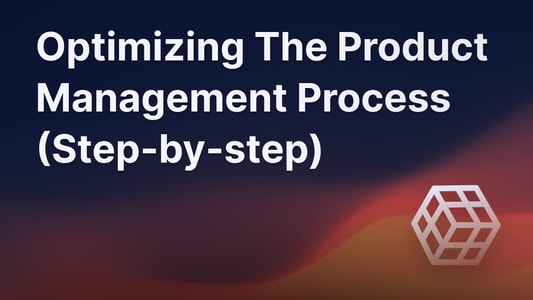Blog RoadmappingShould Your Company Have a Public Roadmap?
Should Your Company Have a Public Roadmap?
Exploring the idea of a public roadmap? In this blog, I'll dive deep into all the pros and potential drawbacks to help you figure out if you should have one for your company.

A public roadmap can be a game-changer in how you engage with your customers as you're inviting them into your company’s development process.
However, it could be a double-edged sword, when your competitors get a full overview of all your plans and just steal them.
In this post, I'll give you a comprehensive overview of everything you should know before implementing a public roadmap. At the end of this, you'll know for sure if a public roadmap is something you'll get a win out of or not.
So, let's get into it! 👇
Understanding the drawbacks of public roadmaps
Implementing a public roadmap might first seem like living in a glass house - where everything you do is closely followed.
It's great when your users know where the product is headed, but what if your competitors start stealing all your great ideas?

That's definitely a valid concern, so let's break it down in more detail to understand it better.
Firstly, blatantly copying ideas often don't end well for your competitors. Each product has its own customer base, which is widely different. What works for you might lead a competitor down an entirely wrong path.
Secondly, consider the alternative of what happens when you don't share your ideas and just work in the dark.
Being scared of sharing your ideas with users and building your product based on assumptions literally never works - unless you're Apple. For every iPhone, there are thousands of startups built in the dark that end up with something no one wants.
Of course, you can still gather input from your customers without making your roadmap public, but that's a lot more time-consuming.
Having a public roadmap is one of the most low-effort/high-impact ways to involve your customers in your decision-making process - making sure you build your product aligned with genuine needs.
Embrace moving fast in your company culture - even if your competitors know absolutely everything you are doing, you'll still be able to crush them just with great execution.
Also, always remember that not everything has to be shown on your public roadmap. There might still be some high-level goals you might want to keep to yourself.
8 Reasons for having a public roadmap

Now that you have an overview of the potential drawbacks of having a public roadmap, let's dive into all the ways public roadmaps are beneficial.
Shortly, public roadmaps are an effective and effortless way to communicate your product vision, manage customer expectations, and keep users in the loop about the progress of ongoing developments.
Let's now hop into the reasons in more detail, so you can better evaluate if public roadmaps are something your company should have.
1. Boost customer engagement and get more feedback
One of the most important aspects of a public roadmap is that it invites your users and customers to share their thoughts and feedback.
No one wants to send feedback into a black hole nor can someone even provide feedback on future ideas, when they don't know what you are planning to add next.
With great public roadmap tools like Featurebase, users can effortlessly provide feedback on upcoming features or suggest improvements, creating a collaborative environment.
This feedback can be incredibly valuable for product managers and help prioritize features that truly meet customer needs.
2. Differentiate yourself from the competition
In crowded markets, a public roadmap can be a huge differentiator.
Imagine having to choose between 2 products:
With the first one, it's easy to communicate feedback, and you're always kept in the loop about what cool new features to expect next. This product's roadmap is transparent, showing a clear timeline of upcoming updates and improvements.
The company regularly updates it, reflecting ongoing customer feedback and market trends. This openness not only keeps customers informed but also deeply involved in the product's evolution.
Contrast this with the second product, where things are vastly different. Here, communication about future developments is minimal or non-existent.
As a user, you feel left in the dark, unsure of what new features might be coming or when. There's a noticeable disconnect between what users want and what the product team is working on.
This lack of transparency and engagement can lead to frustration and a sense of being undervalued.
3. Manage customer expectations
Effectively managing customer expectations is crucial, especially in the tech industry, where products are constantly evolving.
A public roadmap can play a pivotal role in this aspect.
For example, without a public roadmap, customers might frequently contact support asking, "When will this feature be available?" or "Are you planning to fix this issue?".
These repetitive questions not only consume significant time and resources but also indicate a gap in communication. Customers are left guessing about the product's future, leading to uncertainty.
A public roadmap addresses these issues head-on. It provides a clear, visual representation of what the company is working on and when new features or improvements are expected to be released. This transparency helps set realistic expectations.
Customers are less likely to be frustrated if they know what to expect and when. It also reduces the volume of inquiries regarding future updates, allowing the support team to focus on more pressing issues.
4. Build customer trust and loyalty
A public roadmap showcases your commitment to transparency, which can significantly help build trust with your customers.
When users see what's being planned or worked on, they feel more connected and invested in your company's journey.
5. Boost new feature adoption
A public roadmap acts as a promotional tool for future features and improvements.
It generates buzz and anticipation, keeping your user base excited about what’s coming next.
6. Build a community around your product
Public roadmaps can create a sense of community among users.
People who are interested in the direction of your product can engage in discussions, share ideas, and feel like they are part of the product's evolution.
7. Create internal alignment and accountability
Having a public roadmap keeps your internal team aligned on the company's goals and priorities.
It also adds a layer of accountability, as the team is committed to delivering on the promises made publicly.
8. Retain users, attract new customers and investors
A well-structured roadmap can be a powerful tool for attracting new customers and investors.
It showcases your vision, the direction of your product, and your commitment to growth.
A public roadmap is also helpful in retaining customers who are invested in the long-term success of your product.
In summary, a public roadmap is a powerful tool for building customer relationships, creating a collaborative environment, and driving your product forward with clear, shared goals.
How to create a public roadmap?

Creating a public roadmap is easier than you think.
It's important that the tool you choose offers an interactive environment, where users can easily comment their thoughts on ideas.
With all these aspects in mind, we've built the best public road-mapping tool for fast-growing startups that don't want to deal with complex and clunky interfaces.
It integrates with all the tools you already use to plug into your workflow and can be fully set up in under 5 minutes.
Create your public roadmap with Featurebase today →
If you feel like Featurebase isn't right for you, feel free to check out more options from our Top 7 public roadmap tools comparison blog.
Conclusion: Should you have a public roadmap?
The short answer is yes - in most cases, you'll definitely benefit from implementing a public roadmap.
While there are considerations to keep in mind, the benefits of a public roadmap can significantly outweigh the drawbacks.
More reading:
- 12 Public Roadmap Examples for SaaS Companies in 2024 →
- A Simple 6-Step Guide to Plan & Prioritize Your Product Roadmap Effectively →
- Top 7 Public Roadmap Tools for SaaS Companies in 2024 →
- The Best Product Roadmap Examples for SaaS Startups →
FAQ
1. What is a Public Roadmap?
A Public Roadmap is an openly shared plan that outlines your company's future product developments, features, and strategic initiatives. It's a transparent way to communicate with customers and stakeholders about what's coming next.
2. Why Should My Company Consider a Public Roadmap?
Public Roadmaps foster transparency, build trust, and create a collaborative environment with your customers. They help in managing customer expectations, differentiating your product from competitors, and aligning your internal team's efforts.
3. Aren’t We Risking Giving Away Our Ideas to Competitors?
While there's a risk that competitors might see your plans, the benefits often outweigh this concern. Competitors can't easily replicate the unique context or customer relationships you've built. Plus, execution matters more than just ideas.
4. How Do Public Roadmaps Boost Customer Engagement?
They provide a platform for customers to give feedback and suggestions, making them feel involved in your product's development. This engagement is crucial for building a product that truly resonates with your user base.
5. Can a Public Roadmap Help in Product Development?
Absolutely! It can help prioritize features based on real customer feedback and market needs, ensuring you're developing features that add the most value.
The simple feedback tool with feature voting for your customer feedback. Built-in the 🇪🇺.
© 2024 Featurebase. All rights reserved.



